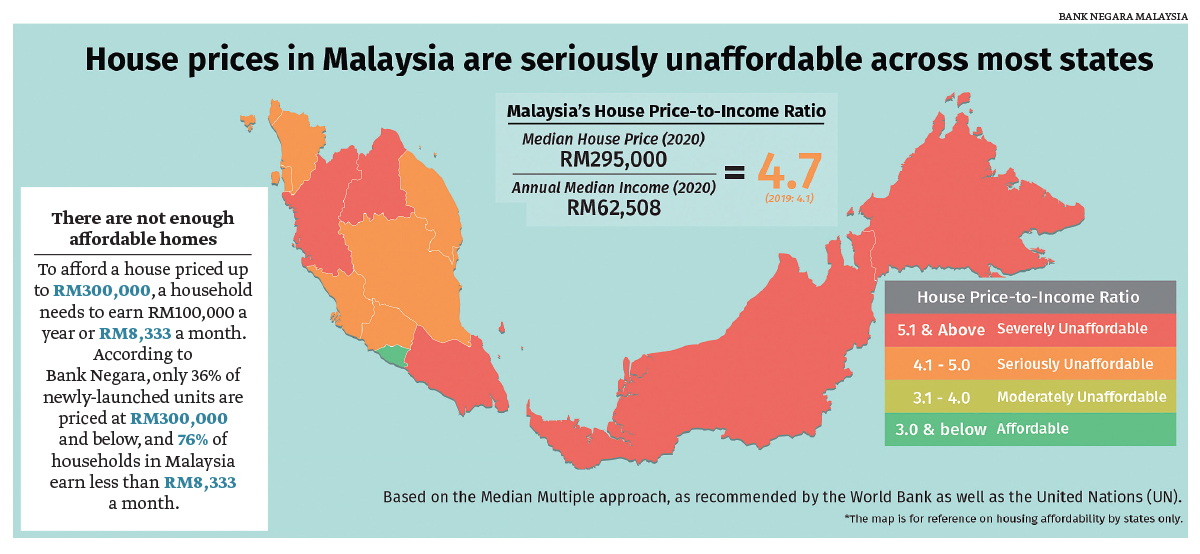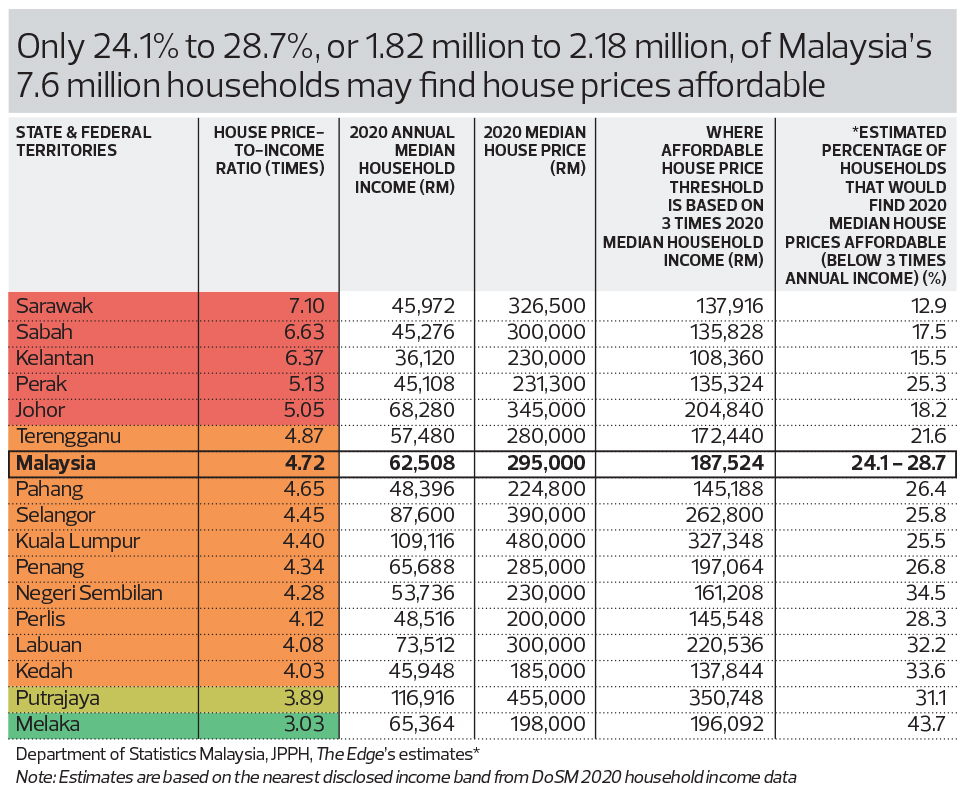
This article first appeared in The Edge Malaysia Weekly on May 2, 2022 - May 8, 2022
HOUSE prices in Malaysia continue to be “seriously unaffordable” for most households, as they have been since at least 2004, with the issue worsened for those whose incomes were hit at the onset of the pandemic, the central bank says.
In a one-page diagram in the 2H2021 Financial Stability Review (2H2021 FSR), released together with the Bank Negara Malaysia 2021 annual report on March 30, the central bank surmised that most Malaysians find houses “seriously unaffordable” due to insufficient income, which leads to low savings and high indebtedness — especially with house prices only growing at a compound annual growth rate of 4.1% per annum between 2014 and 2020, outpacing the 2.1% CAGR for income over the same period.
As affordability remains a major barrier for households, the central bank says “broader reforms to improve housing affordability remain important to reduce the debt burden of households in line with what they can afford and avert risks of future financial hardship”.
While noting in the 2H2021 FSR that “supply-side adjustments have continued with more housing launches shifting towards lower- and mid-price market segments”, Bank Negara also noted a “market failure” in providing enough affordable housing, pointing out that only 35.6% of newly launched housing units since 2015 are priced below RM300,000 whereas 76% of households earn less than the RM8,333 a month needed to afford houses priced above RM300,000.
Malaysia’s house price-to-income ratio hit 4.72 times in 2020 — falling within “seriously unaffordable” levels (4.1 to 5.0 times) based on the Median Multiple (MM) method recommended by the World Bank and United Nations — with the median house price at RM295,000 and median annual household income at RM62,508 in 2020.
That’s above the 4.11 times in 2019 but a shade below 2016’s 4.75 times, according to a back-of-the-envelope calculation based on data from the Department of Statistics Malaysia (DoSM) and the Valuation and Property Services Department (JPPH).
With the median house price at RM310,000 in 2021, according to JPPH data, house prices in Malaysia would only be affordable (house price-to-income ratio of 3 times and below) if the median household income is at least RM8,611 per month. Conversely, it would hit “severely unaffordable” level (house price-to-income ratio of 5.1 times and above) if median household income falls below RM5,065 per month, calculations show. (DoSM has yet to release the 2021 median household income.)
Affordability as low as 12.9%
Only between 24.1% or 1.82 million households and 28.7% or 2.18 million households may find the average house price affordable, having annual income that covers at least one-third of the average house price in the country’s 13 states and three federal territories in 2020, according to The Edge’s estimates based on DoSM and JPPH data for that year. (The MM method defines housing as “affordable” when priced up to three times the annual income.)
Of the 2.25 million households in the Klang Valley, only about 25.8%, or just over 580,000, can afford the 2020 median house price. About 440,000 of them live in Selangor and 129,000 in Kuala Lumpur, The Edge estimates.
In Sarawak, where the house price-to-income ratio is as high as 7.1 times in 2020, only 12.9% or 83,502 households there would deem houses affordable based on the MM method.
In the same vein, the percentage of households that can afford the median home price is only 15.5% in Kelantan, 17.5% in Sabah, 18.2% in Johor, 21.6% in Terengganu, 25.3% in Perak, 25.5% in Kuala Lumpur, 25.8% in Selangor, 26.8% in Penang, 28.3% in Perlis, 31.1% in Putrajaya, 32.2% in Labuan, 33.6% in Kedah and 34.5% in Negeri Sembilan (see table).
Even in Melaka — the only state where the house price-to-income ratio is deemed affordable (3.03 times in 2020) — the median house price of RM235,500 may only be affordable to about 103,000 or 43.7% of households in the state with income of at least RM6,000 a month (rounding up from the RM5,500 affordable threshold based on three times MM).
Housing affordability can hit GDP
Of the RM1.38 trillion debt shouldered by Malaysians as at end-2021, some 58%, or about RM797.5 billion, was from housing loans. That’s up from about RM688.6 billion in housing loans or 55% of total household debt of RM1.25 trillion as at end-2019, central bank data shows.
Owner-occupiers account for two-thirds of the increase in housing debt, with 57.3% of the newly approved loans in 2H2021 given to first-time homebuyers with a higher margin of financing. Some 73.6% of house financing to first-time homebuyers in 2H2021 had loan-to-value (LTV) ratios exceeding 90%, which the central bank says “can be associated with a higher possibility of falling into negative equity” position. It went on to say that credit risks to first-time buyers “are partly mitigated by mortgage guarantees and prudent loan affordability assessments”, which are crucial in averting long-term financial hardship and exclusion, which can result in households losing their homes to foreclosure.
The fact that so much debt is in housing that is “seriously unaffordable” for the majority probably contributed to the lack of savings among households. A lack of buffer is a risk when a sudden crisis hits, as in the case of the pandemic. While affected households were given a temporary moratorium on loan repayments and were allowed access to retirement savings to pare down debt, the drawdown in savings reduces the buffer available in future.
There is also a shorter-term impact on the economy. Calling for “an urgent need to boost housing production and affordability” to prevent a deep social crisis, the authors of a write-up dated March 24, 2022, posted on the World Economic Forum’s (WEF) website noted that the lack of housing affordability is estimated to have reduced GDP output for metro London by US$1.6 billion annually.
Unrealised spending which is “trapped in the housing market” and spent on accommodation due to high housing costs is estimated to be as high as US$7 billion in New York City and US$6 billion in Hong Kong, according to an April 2016 discussion paper by the Global Cities Business Alliance (GCBA) on the economic impact of high housing costs.
“If the cost of housing were lower, consumers would have additional discretionary income (the amount of money left after the purchase of essentials) to spend on other goods and services,” the GCBA report said, also noting that some of the loss would include government spending dedicated to providing housing benefits and social housing to ameliorate high housing costs in the first place. “If more inexpensive options were provided by the housing market, a portion of this government spending could go towards other causes,” it said.
Policies recommended by the WEF article to raise housing affordability and promote social inclusion include having policies to lower the home mortgage burden for consumers. It also recommends policies to lower housing development costs, convert unutilised buildings into residential use, and “up-zoning” or allow taller buildings with higher density while exploring ways to create tax revenue from valuable commercial space to fund affordable housing.
In a June 2019 report, Making Affordable Housing A Reality in Cities, the WEF had recommended that city governments define long-term plans to increase the supply of affordable housing, ensure that developments have adequate infrastructure, and involve non-profit organisations “to bridge the gap between governments and the private sector to improve the affordability of housing as well as work with individuals to help them understand their options and make informed decisions”.
In advocating for an increase in the supply of and a reduction in the cost of affordable housing in its 2016 annual report, Bank Negara had also recommended the development of a thriving rental market so that renting is a viable option of choice rather than a last resort for households. It also advocates the setting up of a central repository to systematically monitor and manage the nation’s affordable housing needs.
If the studies are right about the impact on GDP, the country’s future economic growth would be strengthened if policymakers successfully execute plans to make homes more affordable for all. Better availability of affordable housing and access to public transport would also be in line with the United Nations Sustainable Development (SDG) Goal 11 of making “cities and human settlements inclusive, safe, resilient and sustainable” by 2030.
Save by subscribing to us for your print and/or digital copy.
P/S: The Edge is also available on Apple's App Store and Android's Google Play.
- Greatech down nearly 9% after being flagged as biggest loser in tech following Trump’s new tariffs
- Trump open to tariff cuts in return for ‘phenomenal’ offers
- Trump tariffs sow fears of trade wars, recession and a US$2,300 iPhone
- Trump administration sued over Chinese import tariffs
- China hits back at Trump tariffs with 34% duties on all US goods
- Taiwan unveils US$2.7 bil in help for companies to deal with US tariffs
- Oil tumbles 8% as China retaliates with tariffs on US
- More than just chips: Chinese threats and Trump tariffs could disrupt lots of ‘made in Taiwan’ imports — disappointing US builders, cyclists and golfers alike
- China hits back at Trump tariffs with 34% duties on all US goods
- One of the Fed's top recession alarms sends 2008-style signal


